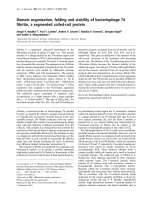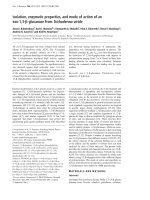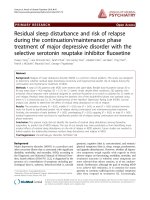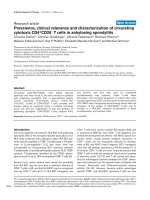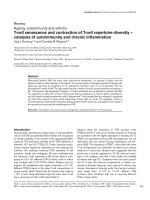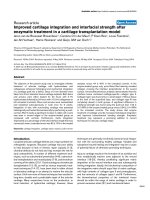Báo cáo y học: "Fluid accumulation, recognition and staging of acute kidney injury in critically-ill patients" doc
Bạn đang xem bản rút gọn của tài liệu. Xem và tải ngay bản đầy đủ của tài liệu tại đây (701.62 KB, 7 trang )
Macedo et al. Critical Care 2010, 14:R82
/>Open Access
RESEARCH
© 2010 Macedo et al.; licensee BioMed Central Ltd. This is an open access article distributed under the terms of the Creative Commons
Attribution License ( which permits unrestricted use, distribution, and reproduction in
any medium, provided the original work is properly cited.
Research
Fluid accumulation, recognition and staging of
acute kidney injury in critically-ill patients
Etienne Macedo
†1
, Josée Bouchard
†1
, Sharon H Soroko
1
, Glenn M Chertow
2
, Jonathan Himmelfarb
3
, T Alp Ikizler
4
,
Emil P Paganini
5
, Ravindra L Mehta*
1
for for the Program to Improve Care in Acute Renal Disease (PICARD) study
Abstract
Introduction: Serum creatinine concentration (sCr) is the marker used for diagnosing and staging acute kidney injury
(AKI) in the RIFLE and AKIN classification systems, but is influenced by several factors including its volume of
distribution. We evaluated the effect of fluid accumulation on sCr to estimate severity of AKI.
Methods: In 253 patients recruited from a prospective observational study of critically-ill patients with AKI, we
calculated cumulative fluid balance and computed a fluid-adjusted sCr concentration reflecting the effect of volume of
distribution during the development phase of AKI. The time to reach a relative 50% increase from the reference sCr
using the crude and adjusted sCr was compared. We defined late recognition to estimate severity of AKI when this time
interval to reach 50% relative increase between the crude and adjusted sCr exceeded 24 hours.
Results: The median cumulative fluid balance increased from 2.7 liters on day 2 to 6.5 liters on day 7. The difference
between adjusted and crude sCr was significantly higher at each time point and progressively increased from a median
difference of 0.09 mg/dL to 0.65 mg/dL after six days. Sixty-four (25%) patients met criteria for a late recognition to
estimate severity progression of AKI. This group of patients had a lower urine output and a higher daily and cumulative
fluid balance during the development phase of AKI. They were more likely to need dialysis but showed no difference in
mortality compared to patients who did not meet the criteria for late recognition of severity progression.
Conclusions: In critically-ill patients, the dilution of sCr by fluid accumulation may lead to underestimation of the
severity of AKI and increases the time required to identify a 50% relative increase in sCr. A simple formula to correct sCr
for fluid balance can improve staging of AKI and provide a better parameter for earlier recognition of severity
progression.
Introduction
The mortality rate in patients with severe acute kidney
injury (AKI) ranges from 40% to 80%, despite advances in
the management of ICU patients and improvement in
dialysis techniques [1-5]. Minimal increases in serum cre-
atinine (sCr) concentration are now recognized as clini-
cally significant events and the severity of AKI has been
associated with a progressive increase in mortality [6-8].
Current diagnostic and staging criteria for AKI are based
on changes in sCr and require sequential measurements
[9,10]. Given the exponential relation of sCr and glomer-
ular filtration rate (GFR), significant decreases in GFR are
reflected as small increases in sCr in the early phases of
injury [11,12]. Consequently, factors influencing sCr
could affect time to recognition of AKI and lead to under-
estimating the severity of renal dysfunction over the
course of AKI. Aside from the well-recognized biological
influences of age, muscle mass, catabolic rate and race
[13,14], alterations in the volume of distribution of creati-
nine (V
Cr
) can in turn alter the sCr concentration.
Animal and human studies have suggested that the V
Cr
is roughly equivalent to total body water (TBW) [15,16].
Among critically-ill patients, especially following surgery
or resuscitation for sepsis or other conditions requiring
massive volume expansion (e.g., burns, pancreatitis, can-
cer chemotherapy or bone marrow transplantation), the
increase in TBW can reach more than 10% within 72
* Correspondence:
1
Division of Nephrology and Hypertension, Department of Medicine,
University of California San Diego San Diego, 200 West Arbor Drive, MC 8342,
San Diego, CA 92103, USA
†
Contributed equally
Full list of author information is available at the end of the article
Macedo et al. Critical Care 2010, 14:R82
/>Page 2 of 7
hours [17,18]. Thus, in addition to its dependence on cre-
atinine generation and clearance (reflecting muscle mass
breakdown and kidney function, respectively), the accu-
racy of sCr measurements as a reflection of kidney func-
tion also depends on TBW. All else equal, higher TBW
results in lower sCr, which can lead to underestimation of
severity of kidney injury.
The Program to Improve Care in Renal Disease
(PICARD) was a multi-center cohort study examining
patient characteristics and practice patterns associated
with adverse and favorable outcomes in patients with AKI
[19]. Laboratory studies and fluid status were obtained
daily throughout the ICU stay. Using data from PICARD,
we hypothesized that a positive cumulative fluid balance
would underestimate the severity of AKI and increase the
time to appropriately stage the disease.
Materials and methods
Study participants
From February 1999 to August 2001, the PICARD study
personnel evaluated for potential study participation all
patients from five academic medical centers who under-
went a nephrology consultation for AKI in the ICU. The
study protocol was approved by the institutional review
boards of the participating institutions and informed
consent was obtained from all patients or their legal rep-
resentatives. AKI was defined as an increase in sCr of 0.5
mg/dL or more for baseline sCr of less than 1.5 mg/dL or
an increase in sCr of 1.0 mg/dL or more for baseline sCr
of 1.5 mg/dL or more and less than 5.0 mg/dL. Chronic
kidney disease (CKD) status was determined at enroll-
ment for each patient by evaluating available clinical and
laboratory data and history. At time of enrollment,
patients were identified as having CKD if they had evi-
dence of elevated sCr, proteinuria, or an abnormal renal
ultrasound within a year prior to the index hospitaliza-
tion. Patients were classified as 'CKD with AKI' if they
met criteria for CKD as defined above. All remaining
patients were considered as 'new-onset AKI'. A complete
description of generation of the PICARD cohort, data
elements, data collection, and management strategies
have been previously described [19]. Of the 618 patients
included in the database, 398 required dialysis, some as
early as at the first day of consultation. We identified 253
AKI patients with three to seven days of consecutive
increase, with no fluctuations in sCr before dialysis initia-
tion. We excluded patients with one day of missing data
for sCr during that phase. sCr was measured at least once
every 24 hours. In this analysis, we compared the first sCr
value available each day with the first sCr value in the
observational period (reference value).
Weight and fluid balance
Admission weights were available in all patients and were
utilized to estimate TBW. Daily fluid balance was deter-
mined from all intakes and outputs recorded. No correc-
tion was made for insensible losses. Cumulative fluid
balance was computed by summing the daily fluid bal-
ances. In the subset of patients with available daily
weights, the change in daily weight was compared with
daily fluid balance.
Correction of sCr for fluid balance
sCr values were adjusted according to the cumulative
daily fluid balance using the formula [20]:
adjusted creatinine = sCr x correction factor
Correction factor = (hospital admission weight (kg) x
0.6 + Σ (daily cumulative fluid balance (L))) / hospital
admission weight x 0.6.
Calculation for underestimation
Underestimation was evaluated in two ways. First, we
computed the differences between the daily adjusted and
crude (measured) sCr values and expressed these as an
absolute change in mg/dL and as a percentage of the
crude value for the day (daily underestimation). Addition-
ally, the time difference to reach a 50% relative increase
from reference based on crude and adjusted sCr was cal-
culated (Figure 1).
daily underestimation = adjusted sCr - crude sCr for
the day
% daily underestimation = (adjusted sCr - crude sCr for
the day) / crude sCr for the day x 100
Difference in time to recognize a 50% increase from ref-
erence sCr = day reached a relative 50% increase in sCr
based on adjusted sCr - day reached a relative 50%
increase in sCr based on crude sCr.
We considered a late recognition in severity progres-
sion when the interval to reach the 50% relative increase
by the crude sCr and adjusted sCr was longer or equal to
one day.
Statistical analyses
Continuous variables were expressed as mean ± standard
deviation or median and interquartile range (IQR), and
compared using either the student's t test or Wilcoxon
rank-sum test, as appropriate. Categorical variables were
expressed as proportions and compared with the chi-
squared. All statistical tests were two-sided and P < 0.05
was considered significant. Statistical analyses were con-
ducted using SPSS 17.0 (Chicago, IL, USA).
Results
Of 253 patients in the development phase of AKI with a
consecutive increase in sCr, the mean age was 60 (± 16.2)
years, 64% were male, and 15% were non-white. Thirty-
one percent had a history of CKD. Mean body weight at
hospital admission was 81.8 (± 20.3) kg. Median daily
Macedo et al. Critical Care 2010, 14:R82
/>Page 3 of 7
urine volume was 1295 mL (IQR 621 to 2145 mL) and
41% of the patients had an episode of oliguria (urine out-
put less than 400 mL/24 hours) for at least one day.
Changes in daily weight and daily fluid balance could be
compared in 82 patients over 212 days and the correlation
(r = 0.452; P < 0.001).
Effect of fluid accumulation on serum creatinine
The median sCr on day 1 was 1.6 mg/dL (IQR 1.2 to 2.2)
and increased to 3.9 mg/dL (IQR 2.8 to 5.6) at day 7. Over
the study period, median cumulative fluid balance
increased from 2.7 L (IQR 0.5 to 6.2) on day 2 to 6.5 L
(IQR 1.1 to 11.3) on day 7 (Table 1). sCr concentrations
adjusted for fluid balance were significantly higher at
each time point and the difference from median crude
and adjusted values progressively increased from 0.09
mg/dL to 0.65 mg/dL. This daily difference in sCr would
translate to a median underestimation of 7.0% (IQR 1.3 to
16%), ranging from 2.1% (IQR 0 to 6.5%) after one day to
14.3% (IQR 4.6% to 27.9%) on day 6 (Table 1).
Patients' characteristics and outcomes among those with
and without late recognition of severity progression
In addition, 64 (25%) patients had an interval of one day
or more to reach a relative 50% increment from reference
creatinine comparing crude and fluid adjusted sCr (Table
2). In 24 (9%) patients this interval was two or more days.
These 64 patients (late recognition) had a higher cumula-
tive fluid balance and consequently a greater difference
between crude and adjusted sCr starting on day 1 (Fig-
ures 2a and 2b). Dialysis was initiated more frequently in
patients with late recognition (71% vs. 58% in patients
with no late recognition, P = 0.061). In-hospital mortality
was not significantly different between the two groups
(40% with late recognition vs. 35% without late recogni-
tion, P = 0.45) (Table 2).
Discussion
Fluid administration is a common and required compo-
nent of the management of critically-ill patients and has
recently focused on goal-directed resuscitation with early
volume expansion in the ICU course. These strategies
frequently result in a relative increase in body weight of
10 to 15% or more, sometimes doubling the TBW in a
short period of time [18,21]. Moran and Myers previously
demonstrated the effect of fluid accumulation on sCr
concentrations and showed that increasing the TBW
alters the volume of distribution of sCr, resulting in
potential for overestimation of the level of kidney func-
tion [20]. As the assessment of AKI is largely based on
changes in sCr, we extended the observations of Moran
and Myers using a cohort of critically-ill patients with
AKI. We hypothesized that fluid accumulation would
underestimate the severity of renal dysfunction based on
sCr and increase the time to detect a change in severity of
injury.
Previous studies have shown varying incidences of AKI
depending on the diagnostic method used, but none has
compared the assessment of severity of AKI in relation to
cumulative fluid balance [22,23]. In this cohort fluid
accumulation progressively increased in patients as kid-
Figure 1 Difference between mean crude and adjusted serum creatinine during the follow-up period (late recognition of severity group).
For conversion of creatinine expressed in conventional units to standard units, multiply by 88.4. AKI: acute kidney injury; sCr: serum creatinine.
Macedo et al. Critical Care 2010, 14:R82
/>Page 4 of 7
ney function declined. The progressive increase in fluid
accumulation resulted in differences as large as 1 mg/dL
between sCr concentrations corrected for cumulative
fluid balance and crude sCr.
Early recognition of AKI has become an area of inten-
sive investigation after studies showing that even small
increases in sCr are associated with increases in mortality
and morbidity. A more precise determination of AKI
severity is an important goal, because mortality with and
complications of AKI appear to be proportional to its
severity [8,24]. For example, Chertow and colleagues
showed a 6.5-fold increase in the odds of death for
patients with a 0.5 mg/dL increase in sCr [8]. In pediatric
patients with acute decompensated heart failure, Gold-
stein and colleagues found that a rise in sCr of 0.3 mg/dL
or more was associated with a seven-fold increased risk
of in-hospital death [25]. Additionally, several studies
have now shown that the change in severity stage of AKI
(acute kidney injury network (AKIN) or risk, injury, fail-
ure, loss of kidney function and end-stage renal failure
(RIFLE)) is associated with an incremental risk for mor-
tality [2,26,27]. An accurate assessment of AKI severity is
essential to developing approaches for earlier interven-
tion, to correct reversible factors, and mitigate the down-
stream effects of AKI. We tested this concept by
establishing a criterion for significant underestimation as
equivalent to the minimum criterion for AKIN stage 1
and RIFLE risk categories as these have been associated
with adverse outcomes [2,26,27]. We found that following
adjustment for fluid accumulation would have allowed
one-quarter of patients to be recognized as having
reached a percentage change in sCr one day earlier. The
masking of AKI severity by volume expansion may be
especially problematic in settings where the sCr is rising
relatively slowly owing either to lower creatinine genera-
tion (e.g., as might be expected in the elderly or patients
with less muscle bulk) or to more modest overall injury.
Our findings have potential practical implications.
Patients included in this study were all analyzed during
the phase of rising sCr. In this situation, clinical decisions
for interventions (wait and see, consultation, diuretics,
dialysis) are based on ascertaining the absolute level of
Table 1: Median daily cumulative fluid balance and serum creatinine (crude and fluid adjusted) in all patients
Median (IQR) Day 1 Day 2 Day 3 Day 4 Day 5 Day 6 Day 7
Cumulative FB (L) 1.0 (-0.1-3.2) 2.7 (0.5-6.2) 3.7 (1.1-8.6) 4.9 (1.7-10.3) 5.6 (2.5-12.0) 6 (1.9-13.1) 6.5 (1.1-11.3)
Crude sCr
(mg/dL)
1.60 (1.2-2.2) 2.10 (1.5-2.8) 2.80 (2.1-3.7) 3.30 (2.6-4.6) 3.80 (2.9-5.5) 3.90 (2.9-5.5) 3.90 (2.8-5.6)
FB adjusted sCr
(mg/dL)
1.69 (1.2-2.3) 2.24 (1.6-3.1) 2.99 (2.3-4.2) 3.79 (2.8-5.2) 4.29 (3.2-6.3) 4.44 (3.4-6.3) 4.55 (3.4-6.6)
% Underestimation 2.1 (0-6.5) 5.4 (0.9-13.1) 8.3 (2.18-17.9) 10.5 (3.2-21.8) 13.4 (4.8-25.8) 14.3 (4.6-27.9) 13.6 (2.8-26.9)
FB: fluid balance; IQR: interquartile range; sCr: serum creatinine.
For conversion of creatinine expressed in conventional units to standard units, multiply by 88.4.
% Daily underestimation = (Adjusted sCr - crude sCr for the day) crude sCr for the day × 100
Figure 2 (a) Cumulative fluid balance and (b) difference between adjusted and crude sCr during the observation period in patients with
and without late recognition of severity. (a) * P < 0.001; ** P = 0.003; *** P = 0.007. (b) P < 0.001 all days. AKI: acute kidney injury; sCr: serum creatinine.
Macedo et al. Critical Care 2010, 14:R82
/>Page 5 of 7
sCr and the rate of change over a set period of time. Clini-
cians generally assess the daily change in sCr and change
over the duration of the episode to gauge the severity of
AKI at any time point. Perhaps individual values for sCr
should be adjusted for the cumulative fluid balance to
provide a more accurate assessment of the current sever-
ity of AKI on any given day. sCr level is a function of crea-
tinine production and renal excretion, and the increment
in sCr levels on each day is an approximation of the cata-
bolic rate. In AKI critically-ill patients, the catabolic rate
is likely to be increased and the creatinine production is
unstable. Correcting sCr for fluid balance prior to calcu-
lating the creatinine production would provide more pre-
cise evaluation of the catabolic state to ascertain the true
change in creatinine that could be masked by significant
fluid accumulation.
As shown in Figure 1, the difference in crude and
adjusted sCr increases over time and reflects the need to
assess cumulative fluid balance rather than daily fluid bal-
ance alone as the latter may be negative, positive or even
on any given day. Additionally, comparison of the fluid
adjusted sCr to the reference creatinine at any given point
might lead to an earlier delineation of a change AKI stag-
ing. As an adequate assessment of AKI severity can lead
to an earlier implementation of preventive and therapeu-
tic strategies, such as avoiding radiocontrast or discontin-
uing potential nephrotoxic drugs, adjusting medication
dosages, and correcting hemodynamic status in an early
phase of kidney injury, earlier recognition could be of
value [2,28-30].
This study has several strengths. The PICARD cohort
was assembled from five academic medical centers geo-
graphically distributed across the USA, with demo-
graphic and clinical characteristics reasonably
representative of critically-ill patients with AKI. In con-
trast to many other studies where information was col-
lected upon initial review or around the time of initiation
of dialysis, data from patients enrolled in PICARD were
collected from three days preceding the day of AKI diag-
nosis throughout their ICU course. Although several
years have passed since the PICARD data were collected,
many of the same issues facing patients with AKI remain.
PICARD affords us with extraordinarily detailed clinical
data on a relatively large cohort. Other administrative
databases, although powerful, lack the clinical detail
available in PICARD.
This study also has several important limitations. First,
the problem of under-ascertainment may have led to even
more underestimation or late recognition of AKI by the
more stringent enrollment criteria employed in PICARD
(requiring a 0.5 mg/dL increase in sCr in contrast to an
0.3 mg/dL increase in AKIN). Indeed, underestimation of
AKI severity due to dilution of sCr by volume accumula-
tion is likely to be more common in patients with mild
AKI than in more severe cases, where the sCr rises rap-
idly and to a sufficient level (e.g., >2 mg/dL) where it is
easily recognized in spite of dilution. However, even in
Table 2: Patients' characteristics and outcomes All patients and patients with and without late recognition of severity
All patients Patients with late
recognition
Patients without
late recognition
n = 253 n = 64 n = 189
Race - Caucasian 85% 87% 84%
Race - African American 6.3% 3.1% 7.4%
Gender - male 63% 59% 65%
Serum creatinine - day 1- mg/dL median (IQR) 1.6 (1.2-2.2) 1.65 (1-2.4) 1.60 (1.2-2.2)
CKD status n (%) 79 (31) 16/62 (25) 63/187 (33)
Daily urine volume - mL median (IQR) 1295 (621-2145) 1151 (475-1955) 1338 (670-2200)*
Oliguria <400 ml/24 hours - n (%) 103 (40.7) 31/64 (48) 72/189 (38)
Daily fluid balance (L/24 h) - median (IQR) 0.7 (-0.3-2.3) 1.6 (0.0-3.6) 0.5 (-0.4-2.0)**
Total fluid accumulation (L) - median (IQR) 4.9 (0.6-10.9) 11.2 (5.5-16.5) 3.2 (-0.7-7.3) **
Total fluid accumulation as % of body weight - median (IQR) 6.4 (0.7-14.4) 15.6 (7.0-21.3) 4.2 ( 8-10.3) **
Need for dialysis 157/253 (52) 46/64 (71) 111 (58) ***
Hospital mortality 93/253 (36) 26/64 (40) 67/189 (35)
* P = 0.003; ** P < 0.001; *** P = 0.061 (not significant)
CKD: chronic kidney disease; IQR: interquartile range.
For conversion of creatinine expressed in conventional units to standard units, multiply by 88.4.
Macedo et al. Critical Care 2010, 14:R82
/>Page 6 of 7
these circumstances there is an incremental change in the
time to detect a change in severity of AKI. Daily weight
was available in a small proportion of patients and daily
fluid balance is certainly subject to variation, because it
does not account for insensible losses. However, daily
fluid balance is a widely used method of assessing
changes in volume status and it showed a positive corre-
lation with weight increase in our cohort. We did not dif-
ferentiate the type and nature of fluid given (colloid,
crystalloids or nutritional supplements) and we could not
ascertain all of the reasons for fluid accumulation. It
would have been informative to know whether fluid
(rather than pressors) was administered for the purpose
of treating hypotension or in conjunction with other
medications or nutritional support. We could not calcu-
late creatinine production in our patients as we did not
have urinary creatinine measurements in the majority of
these patients. Finally, although volume accumulation
clearly alters sCr in the 'development' phase of AKI [31]
and could change practice patterns, it would also be
informative to consider volume effects during the 'recov-
ery' phase of AKI when sCr stabilizes and begins to
decline. Although arguably less critical to patient out-
comes, appropriately recognizing the pace of recovery by
the decline in adjusted rather than crude sCr could help
to rationalize inpatient and follow-up care after resolu-
tion of critical illness.
Conclusions
In critically-ill patients, a positive fluid balance may lead
to underestimation of the severity of AKI and delay the
recognition of a 50% relative increase in sCr. The use of a
simple formula to correct for fluid balance may allow for
a more accurate determination of AKI severity in criti-
cally-ill patients. Future studies, including observational
cohort studies and randomized clinical trials of patients
with AKI, should consider the influence of fluid balance
on sCr when designing inclusion criteria for participa-
tion.
Key messages
• Positive fluid balance is common in the develop-
ment phase of AKI
• Fluid accumulation increases the TBW and alters
the volume of distribution of sCr
• The severity of AKI can be underestimated in
patients with net positive fluid balance in the devel-
opment phase of AKI
• Underestimation of sCr values can delay the recog-
nition of a 50% relative increase in sCr
• Correcting sCr for fluid accumulation may allow for
a more accurate determination of AKI severity in crit-
ically-ill patients
Abbreviations
AKI: acute kidney injury; AKIN: Acute Kidney Injury Network; CKD: chronic kid-
ney disease; GFR: glomerular filtration rate; IQR: interquartile range; PICARD:
Program to Improve Care in Renal Disease; RIFLE: risk, injury, failure, loss of kid-
ney function and end-stage renal failure; sCr: serum creatinine; TBW: total body
water; V
Cr
: volume of distribution of creatinine.
Authors' contributions
EM, JB, GMC, and RLM were involved in the conception, design, analysis and
interpretation of data, drafting the article and revising it critically for important
intellectual content and final approval of the version to be published. SS was
involved in the analysis and interpretation of data, revising the article for
important intellectual content and final approval of the version to be pub-
lished. JH, TAI, and EPP were involved in the acquisition, analysis and interpreta-
tion of data, revising the article for important intellectual content and final
approval of the version to be published.
Acknowledgements
The study was supported by the following research grants: National Institutes
of Health: NIH-NIDDK RO1-DK53412, RO1-DK53411, and RO1-DK53413. Etienne
Macedo's work has been made possible through an International Society of
Nephrology Fellowship and CNPq (Conselho Nacional de Desenvolvimento
CientÍfico eTecnológico) support. Josée Bouchard is a recipient of a research
fellowship from the Kidney Foundation of Canada. Institutions where work was
performed: University of California, San Diego, CA, USA; University of California,
San Francisco, CA, USA; Cleveland Clinic Foundation, Cleveland, OH, USA; Van-
derbilt University, Nashville, TN, USA and Maine Medical Center, Portland, OR,
USA.
Author Details
1
Division of Nephrology and Hypertension, Department of Medicine,
University of California San Diego San Diego, 200 West Arbor Drive, MC 8342,
San Diego, CA 92103, USA,
2
Division of Nephrology, Department of Medicine,
Stanford University School of Medicine, 780 Welch Road, Suite 106, Palo Alto,
CA 94034, USA,
3
Kidney Research Institute, Division of Nephrology,
Department of Medicine, University of Washington, 908 Jefferson St, Seattle,
WA 98104, USA,
4
Division of Nephrology, Department of Medicine Vanderbilt
University School of Medicine,638 Robinson Research Building, 2200 Pierce
Avenue, Nashville, TN 37232-0146, USA and
5
Division of Nephrology,
Department of Medicine, Cleveland Clinic Foundation, 9500 Euclid Avenue,
Cleveland, OH 44195, USA
References
1. Abosaif NY, Tolba YA, Heap M, Russell J, El Nahas AM: The outcome of
acute renal failure in the intensive care unit according to RIFLE: model
application, sensitivity, and predictability. Am J Kidney Dis 2005,
46:1038-1048.
2. Hoste EA, Clermont G, Kersten A, Venkataraman R, Angus DC, De Bacquer
D, Kellum JA: RIFLE criteria for acute kidney injury are associated with
hospital mortality in critically ill patients: a cohort analysis. Crit Care
2006, 10:R73.
3. Metcalfe W, Simpson M, Khan IH, Prescott GJ, Simpson K, Smith WC,
MacLeod AM: Acute renal failure requiring renal replacement therapy:
incidence and outcome. QJM 2002, 95:579-583.
4. Uchino S, Bellomo R, Goldsmith D, Bates S, Ronco C: An assessment of
the RIFLE criteria for acute renal failure in hospitalized patients. Crit
Care Med 2006, 34:1913-1917.
5. Uchino S, Bellomo R, Morimatsu H, Morgera S, Schetz M, Tan I, Bouman C,
Macedo E, Gibney N, Tolwani A, Doig GS, Oudemans van Straaten H,
Ronco C, Kellum JA: External validation of severity scoring systems for
acute renal failure using a multinational database. Crit Care Med 2005,
33:1961-1967.
6. Kellum JA, Levin N, Bouman C, Lameire N: Developing a consensus
classification system for acute renal failure. Curr Opin Crit Care 2002,
8:509-514.
7. Mehta RL, Kellum JA, Shah SV, Molitoris BA, Ronco C, Warnock DG, Levin A:
Acute Kidney Injury Network: report of an initiative to improve
outcomes in acute kidney injury. Crit Care 2007, 11:R31.
Received: 7 January 2010 Revised: 19 March 2010
Accepted: 6 May 2010 Published: 6 May 2010
This article is available from: 2010 Macedo et al.; licensee BioMed Central Ltd. This is an open access article distributed under the terms of the Creative Commons A ttribution License ( which permits unrestricted use, distribution, and reproduction in any medium, provided the original work is properly cited.Critical Care 2010, 14:R82
Macedo et al. Critical Care 2010, 14:R82
/>Page 7 of 7
8. Chertow GM, Burdick E, Honour M, Bonventre JV, Bates DW: Acute kidney
injury, mortality, length of stay, and costs in hospitalized patients. J Am
Soc Nephrol 2005, 16:3365-3370.
9. Bellomo R, Ronco C, Kellum JA, Mehta RL, Palevsky P: Acute renal failure -
definition, outcome measures, animal models, fluid therapy and
information technology needs: the Second International Consensus
Conference of the Acute Dialysis Quality Initiative (ADQI) Group. Crit
Care 2004, 8:R204-212.
10. Liano F, Gallego A, Pascual J, Garcia-Martin F, Teruel JL, Marcen R, Orofino
L, Orte L, Rivera M, Gallegoa N, Quereda C, Ortuño J: Prognosis of acute
tubular necrosis: an extended prospectively contrasted study. Nephron
1993, 63:21-31.
11. Lameire N, Hoste E: Reflections on the definition, classification, and
diagnostic evaluation of acute renal failure. Curr Opin Crit Care 2004,
10:468-475.
12. Star RA: Treatment of acute renal failure. Kidney Int 1998, 54:1817-1831.
13. Jones CA, McQuillan GM, Kusek JW, Eberhardt MS, Herman WH, Coresh J,
Salive M, Jones CP, Agodoa LY: Serum creatinine levels in the US
population: third National Health and Nutrition Examination Survey.
Am J Kidney Dis 1998, 32:992-999.
14. Levey AS: Measurement of renal function in chronic renal disease.
Kidney Int 1990, 38:167-184.
15. Schloerb PR: Total body water distribution of creatinine and urea in
nephrectomized dogs. Am J Physiol 1960, 199:661-665.
16. Edwards KD: Creatinine space as a measure of total body water in
anuric subjects, estimated after single injection and haemodialysis.
Clin Sci 1959, 18:455-464.
17. Wiedemann HP, Wheeler AP, Bernard GR, Thompson BT, Hayden D,
deBoisblanc B, Connors AF Jr, Hite RD, Harabin AL: Comparison of two
fluid-management strategies in acute lung injury. N Engl J Med 2006,
354:2564-2575.
18. Perko MJ, Jarnvig IL, Hojgaard-Rasmussen N, Eliasen K, Arendrup H:
Electric impedance for evaluation of body fluid balance in cardiac
surgical patients. J Cardiothorac Vasc Anesth 2001, 15:44-48.
19. Mehta RL, Pascual MT, Soroko S, Savage BR, Himmelfarb J, Ikizler TA,
Paganini EP, Chertow GM: Spectrum of acute renal failure in the
intensive care unit: the PICARD experience. Kidney Int 2004,
66:1613-1621.
20. Moran SM, Myers BD: Course of acute renal failure studied by a model of
creatinine kinetics. Kidney Int 1985, 27:928-937.
21. Bouchard J, Weidemann C, Mehta RL: Renal replacement therapy in
acute kidney injury: intermittent versus continuous? How much is
enough? Adv Chronic Kidney Dis 2008, 15:235-247.
22. Zappitelli M, Parikh CR, Akcan-Arikan A, Washburn KK, Moffett BS,
Goldstein SL: Ascertainment and epidemiology of acute kidney injury
varies with definition interpretation. Clin J Am Soc Nephrol 2008,
3:948-954.
23. Bagshaw SM, George C, Bellomo R: A comparison of the RIFLE and AKIN
criteria for acute kidney injury in critically ill patients. Nephrol Dial
Transplant 2008, 23:1569-1574.
24. Hoste EA, Kellum JA: RIFLE criteria provide robust assessment of kidney
dysfunction and correlate with hospital mortality. Crit Care Med 2006,
34:2016-2017.
25. Goldstein S, Denfield S, Mott A: "Mild" renal insufficiency is associated
with poor outcomes in children with acute decompensated heart
failure. Evidence for a pediatric cardiorenal syndrome. Renal Week 2005;
November 8-13, 2005, Philadelphia, PA: Poster F-PO908 .
26. Ali T, Khan I, Simpson W, Prescott G, Townend J, Smith W, Macleod A:
Incidence and outcomes in acute kidney injury: a comprehensive
population-based study. J Am Soc Nephrol 2007, 18:1292-1298.
27. Ricci Z, Cruz D, Ronco C: The RIFLE criteria and mortality in acute kidney
injury: A systematic review. Kidney Int 2008, 73:538-546.
28. Ronco C, Bellomo R: Prevention of acute renal failure in the critically ill.
Nephron Clin Pract 2003, 93:C13-20.
29. Chertow GM, Levy EM, Hammermeister KE, Grover F, Daley J:
Independent association between acute renal failure and mortality
following cardiac surgery. Am J Med 1998, 104:343-348.
30. Metnitz PG, Krenn CG, Steltzer H, Lang T, Ploder J, Lenz K, Le Gall JR, Druml
W: Effect of acute renal failure requiring renal replacement therapy on
outcome in critically ill patients. Crit Care Med 2002, 30:2051-2058.
31. Molitoris BA, Sutton TA: Endothelial injury and dysfunction: role in the
extension phase of acute renal failure. Kidney Int 2004, 66:496-499.
doi: 10.1186/cc9004
Cite this article as: Macedo et al., Fluid accumulation, recognition and stag-
ing of acute kidney injury in critically-ill patients Critical Care 2010, 14:R82


